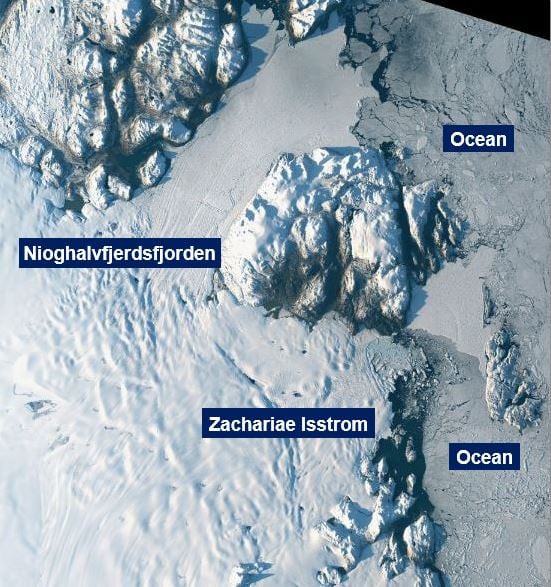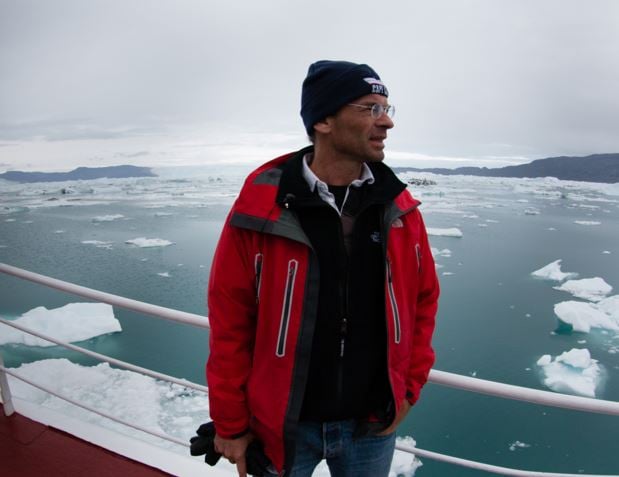A giant Greenland glacier – Zachariae Isstrom – that holds enough water to raise sea levels globally by at least 18 inches, has become dislodged from a stabilizing sill and is crumbling into the ocean.
The glacier is losing mass at a rate of 5 billion tons annually – that is the equivalent in weight to slightly more than 60 billion adult humans each year.
In 2012, Zachariae Isstrom entered a phase of ‘accelerated retreat’, according to researchers from the University of California, Irvine (UCI), the University of Kansas and NASA’s Jet Propulsion, who published their findings in the journal Science.
 Satellite photograph taken August 30, 2014, of Zachariæ Isstrøm and Nioghalvfjerdsfjorden, two huge glaciers in northeast Greenland. Landsat (Credit: NASA / USGS)
Satellite photograph taken August 30, 2014, of Zachariæ Isstrøm and Nioghalvfjerdsfjorden, two huge glaciers in northeast Greenland. Landsat (Credit: NASA / USGS)
Lead author Jeremie Mouginot, an associate project scientist at UCI’s Department of Earth System Science, said:
“North Greenland glaciers are changing rapidly. The shape and dynamics of Zachariae Isstrom have changed dramatically over the last few years. The glacier is now breaking up and calving high volumes of icebergs into the ocean, which will result in rising sea levels for decades to come.”
The scientists used data from aerial surveys carried out by NASA’s Operation IceBridge (a mission that aims to monitor changes in polar ice from a fixed-wing aircraft) and satellite-based observations gathered by several different space agencies (NASA, CSA, DLR, JAXA, ESA and ASI) coordinated by the Polar Space Task Group.
The ultra-sensitive radar sounder, laser profiling systems and gravimeter, together with optical and radar images from space, monitor and record changes in the position, size and shape of glacial ice over extended periods, providing accurate and detailed data on the state of Earth’s polar regions.
Bottom of Zachariae Isstrom being eroded
The scientists determined that warmer ocean temperatures mixed with increasing amounts of meltwater from the ice sheet surface are rapidly eroding the bottom of Zachariae Isstrom.
Dr. Mouginot said:
“Ocean warming has likely played a major role in triggering [the glacier’s]retreat, but we need more oceanographic observations in this critical sector of Greenland to determine its future.”
 Prof. Rignot standing aboard the 294-ton Cape Race, from which he and his colleagues measured Greenland’s melting glaciers in summer of 2014. (Image Credit: Maria Stenzel/for UCI)
Prof. Rignot standing aboard the 294-ton Cape Race, from which he and his colleagues measured Greenland’s melting glaciers in summer of 2014. (Image Credit: Maria Stenzel/for UCI)
Senior author, Eric Rignot, Chancellor’s Professor of Earth System science at UCI, said:
“Zachariae Isstrom is being hit from above and below. The top of the glacier is melting away as a result of decades of steadily increasing air temperatures, while its underside is compromised by currents carrying warmer ocean water, and the glacier is now breaking away into bits and pieces and retreating into deeper ground.”
Another huge glacier also melting rapidly
Nioghalvfjerdsfjorden, another giant glacier (Zachariae Isstrom’s neighbor), is also melting fast, but is receding at a slower pace because an inland hill is protecting it.
The two giant glaciers make up 12% of Greenland’s ice sheet, and would raise global sea levels by over 39 inches if they completely collapsed.
Prof. Rignot noted:
“Not long ago, we wondered about the effect on sea levels if Earth’s major glaciers were to start retreating. We no longer need to wonder; for a couple of decades now, we’ve been able to directly observe the results of climate warming on polar glaciers. The changes are staggering and are now affecting the four corners of Greenland.”
The study is being funded by NASA’s Cryospheric Sciences Program.
Citation: “Fast retreat of Zachariæ Isstrøm, northeast Greenland,” J. Mouginot, E. Rignot, B. Scheuchl, I. Fenty, A. Khazendar, M. Morlighem, A. Buzzi, and J. Paden. Science aac7111. Published online 12 November 2015. DOI:10.1126/science.aac7111.
UCI Video – Measuring Earth’s meltdown in Greenland
A Greenland expedition with Prof. Rignot and Isabella Velicogna reveals the ‘time bomb’ effects of global warming.

